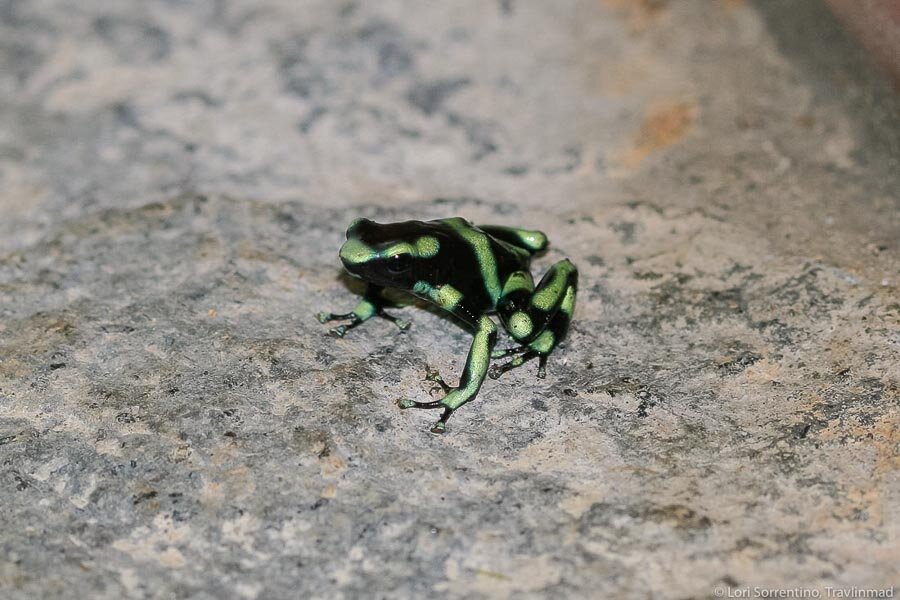Costa Rica Bugs & Insects You May Encounter (and What to Do!)
Want to know what Costa Rica bugs, insects and other crawly things you might encounter in this green eco destination?
The small country of Costa Rica in Central America is one of my favorite parts of the world. From therainforests and wild junglesof the Pacific Ocean on one side and theCaribbean sideon the other, the landscape here is as diverse as the people, languages, history, culture, and cuisine.
Costa Rica hasso much to see and explore, one could easily spend a lifetime discovering this region alone and never see the same place twice.
But with all the adorablemonkeysand amazingwildlife in Costa Rica, the one thing I’m not crazy about are the creepy, crawly critters that may decide to pay you a visit inside your eco-lodge or hotel room at night.
There's no shortage of insects in Costa Rica — bugs, flying insects, things that crawl, jump, and startle you during the day and yes, even at night. Yuck!
But don’t be too skeeved out! If an arachnophobe like me can handle it, so can you. And honestly, they don’t want to have anything to do with you either. ;-)
Even the most chic accommodations won't necessarily shield you from some of the smaller residents who call this place home. Beside, they were here long before we decided to visit.
Here are a few bugs, insects, and spiders you might find in Costa Rica - but KEEP CALM and DON'T PANIC!
Here is also what to do if you find them — or they find you! ;-)
This post may contain affiliate links. If you click through and make a qualifying purchase, we may earn a small commission at no extra cost to you.
Costa Rica Frogs and Toads
Poisonous Dart Frogs
Several types of poisonous dart frogs exist in Central America, but most are not poisonous to humans, unless of course you happen to ingest the toxic substance on their skin.
You’ll find tons of these critters aroundDrake Bayand in Corcovado National Park on the Osa peninsula.
Depending on the species, they can be yellow, copper, gold, red, blue, green, black or a combination of those colors.
Of the several hundred species in the world, only a few have toxic effects that could kill a human being.
If you accidentally touch one, wash the affected area with soap and an antibacterial lotion.
Frogs and Toads
There are many frogs and toads in Costa Rica, and one in particular is good to stay away from — theCane Toad.
The giantBufo Cane Toad(left and middle, below) is an invasive species in Costa Rica (and other parts of the world), brought there to control pests in the banana plantations near Limon, but eventually they became pests themselves.
Cane toads are also highly invasive in south Florida and can be very harmful to dogs and other pets who unwittingly lick or put them in their mouth.
Can toads emit a toxin through their skin calledbufo toxin, so if you see one, don't pick it up — and steer your dogs away from them.
The blue-eyedBufo(below) was waiting for me near our bed one morning, and I was immediately struck by his amazing blue eyes! Seriously! Aren't they cool?
But they're invasive. If you do come into contact with one, wash your skin immediately with soap and antibacterial lotion.
The ever-presentGreen-eyed Tree Frogon the other hand, is the poster frog for Costa Rica and they always make for good photo ops.
These little guys are harmless and always willing to stay still for the shot!
Common Costa Rica Bugs
Leaf Cutter Ants
Lines ofleaf cutter antsare fascinating to watch! Like workers on a mission, watching hundreds of them in a single-file line haul pieces of leaves on their back is like watching a precision maneuver.
Leaf cutter ants are generally harmless, unless you come across one of theirsoldiers— the larger ants who protect the nest. They can deliver a nasty bite. Even Army ants avoid them!
Army Ants
Speaking of Army ants, these critters are scary, even to human beings! We’ve heard horror stories from Ticos and expats who’ve had Army ants move in and destroy their home, furnishings, even injure or kill their small pets.
As their name suggests, Army ants move through an area in enormous waves, leaving swaths of destruction in their wake. They have strength in numbers.
On a hike one year on theOsa peninsula, our Naturalist Guide drew in an army by first moving our group off to the side, then stomping his foot on the ground repeatedly, until they came.
We watched as the underbrush came to life, the ground cover swaying in a giant pattern of 10 meters wide, until we saw them and got out of their way.
They will bite you! So tread lightly on the jungle floor!
Army ants can be incredible destructive, but many locals take a different view
Walking Sticks
Have you ever seen this interesting insect? There are over 3,000 varieties around the world, but in Costa Rica they're commonly green or brown, and they camouflage themselves to mimic tree branches and twigs.
They're interesting, slow moving, and not at all harmful.
The best thing to do is take a quick pic and let them alone to move on.
If it freaks you out to have them around, simply pick it up at the tail end away from its antennae and place it outside.
Walking stick bugs look just like small twigs!
Mantis
We found this interesting looking bug in our cabina at Bosque del Cabo on the Osa peninsula — it’s aGreen Hooded Mantis, looking a little green around the gills :-)
His size alone was impressive — about 6-7" from head to tail. There are many varieties of mantis but I’ve never seen one like this before.
And although he was cool to look at, I would havefreaked outif this thing had landed directly on me!!
Green Hooded Mantis
Costa Rica Spiders
有很多蜘蛛在哥斯达黎加但大多数of them are truly harmless. And believe me, I’ve had to play that on repeat to myself for many years whenever I visit.
Here’s the weird part — I really hate spiders (ever since I woke up with one in my hair as a kid (huge!) but that’s a story for a different day!
But I don’t mind spiders in the outdoors. Isn’t that strange. Outdoors = not bad. Indoors or in my home = bad…very, very bad.
Spiders
The spiders you’ll see most often in Costa Rica are the common orb weavers. TheGolden Orb Weaver(below) can be as large as 3-4 inches in length.
But they won’t hurt you. They’re all about weaving their web and finding some poor sucker to wander through it. That’s about it!
一些蜘蛛更激进,喜欢这种冒险乐园g spider in the middle (sorry, I don’t know what kind it is), who will leap from leaf to leaf. And the one on the right, we just steered clear of!
金色的Orb韦弗、哥斯达黎加最常见的一种d harmless spider
Scorpions
OK, I've saved theworst for last!Scorpions literally make me feel sick to my stomach.
I think it's because of my first experience with black scorpions in Belize, when several of them got inside our cabana at night, hidden inside the folds of the window curtains.
One swipe with a flip-flop and they were toast. Apparently, they're extremely fragile and almost disintegrated on the floor.
Unfortunately, no one mentioned at our eco-hotel that we might run into them before we went to bed, and we spent the entire night awake in our bed thinking we'd be dead by morning with a single sting.
It wasn't until the next morning when we were told their sting was similar to that of a bee - a bad sting, but generally not life-threatening.
Still, it's important to know you might encounter these guys in Central America, and to being along your Epi-Pen if you use one.
This Brown Scorpion (below) was in our room on the Osa peninsula, hiding among the wooden louvers of the bathroom door.
He appeared just hours after we commented to someone at dinner how we'd never seen scorpions in Costa Rica!
The next morning at breakfast, this is how Philip the Resident Naturalist described being stung by a scorpion - "You'll feel a stabbing pain for about 10 seconds, followed by massive throbbing for 20 minutes or so, and then you're done!"
Scorpions in Costa Rica will case a nasty sting, but are generally not lethal
TIPS to Avoid Getting Stung (and What to Do If…)
Always Shake Out Your Shoes and Clothing!
I learned the lesson below a few years ago in Costa Rica, seconds before I slipped my toe inside myKeensfor the day: always —always— shake out your clothing and shoes and double check before you put them on!
A Halloween Crab claw on my toe would not have been pleasant, I can tell you that!
Halloween crab napping in my shoes in Costa Rica
Wear Insect Repellant
This is your first line of defense against biting insects. We have foundthis one to be effectiveon our visits to Costa Rica.
After A Bite or Sting
Even if you’re not overly sensitive to insect bites, it’s a good idea to pack an after bite product.
There are many to choose from but we preferthis oneto relieve itching.
Stings are another story all together. You’ll want quick pain relief andthis productwill do just that.
Epipen
There are some critters in Costa Rica that can deliver a pretty nasty bite. If you already carry an epipen for allergic reactions be sure to bring it along.
Over the Counter Itch Relief
Consider hydrocortisone cream for itching or maybe benadryl for relief. Both are over the counter medications and can be found in any drugstore.
Had enough of the bugs in Costa Rica?
It's not as bad as it seems, and always an adventure in the jungles of Central America!









